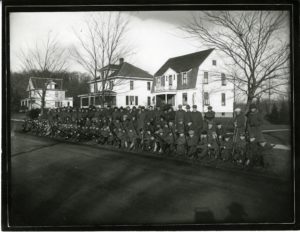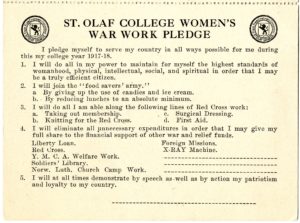Highlights of the World War I digitization project, part 3
Today I am continuing to share with you some of the great resources I have been able to digitize as a part of this World War I project.
Another uniquely Northfield experience during World War I that I have been exploring was the Student Army Training Corps. The War Department created units of these corps at both St. Olaf and Carleton Colleges. The idea behind these units was to create a group of student-soldiers who continued in their academic pursuits but also received military training. Theoretically, men with this dual training would become better officers for the U.S. Army if the war continued.
However, the S.A.T.C. was only in operation from October 1 to December 10, 1918. The relatively late induction of men into the companies, the signing of the Armistice in November, and the influenza epidemic all limited the effectiveness of the Corps. Even so, 228 men served in two companies at St. Olaf and were proud of their service to the country in this way.

Student Army Training Corps on St. Olaf Avenue, 1918. St. Olaf College Archives. Note the lack of uniform hats and evidence of disorganization in their poses. See it on the DHC.
The women of St. Olaf College also were determined to prove they were patriotic and loyal Americans, as well. They developed a women’s war work pledge in the fall of 1917 vowing to volunteer their time, talents, and funds towards war-related activities. Most of them participated in Red Cross work at the college, attended first aid and food preservation courses, and even formed their own Red Cross Auxiliary.

St. Olaf College Women’s War Work Pledge, 1917. St. Olaf College Archives. See it on the DHC.
You can learn more about the St. Olaf College experience during the war in this special issue of the St. Olaf College Bulletin, published quarterly by the faculty of St. Olaf College. This issue includes a list of names of the St. Olaf men who participated in World War I. It also describes the St. Olaf response to the war in greater detail, including the formation of its Student Army Training Corps (S. A. T. C.) and its women’s War Work Institute. Plus, the St. Olaf College Archives also has some materials about the Corps on their website, too.

Why would a young man of a poor background,and didn’t like his parents –
graduate from St Olaf’s about 1915;
and then transfer to the University of Kentucky at Louisville?
I assume he joined the ROTC there.